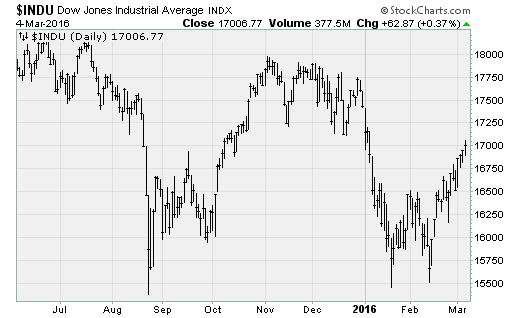How the Dow can finally get back to 18,000
A better-than-expected payroll gain for February kept U.S. equities on the rise Friday, pushing the Dow Jones industrials index back over the 17,000 level for the first time since early January and continuing the recent melt-up off February's lows.
The jobs report had a "goldilocks" quality to it: Strong enough to assuage fears of an economic slowdown in the U.S. but not hot enough to encourage rapid rate hikes from the Federal Reserve. While the labor market is tightening, new entrants into the workforce kept the unemployment rate stable at 4.9 percent. Moreover, wage gains were disappointingly modest.
All of this was exactly what the bulls were looking for. But can it continue and help the blue-chip Dow push past 18,000 -- a level not exceeded since last summer (chart below)?
Much depends on what the Fed does from here. Economists from both Bank of America Merrill Lynch and Capital Economics expect the central bank to hold off on rate hikes this month but then pull the trigger in June.
That's ahead of where the market is. Before today's jobs numbers, the futures market wasn't expecting a rate hike until 2017. Now, that has been brought forward to November.
The Fed is still officially maintaining its forecast for four quarter-point rate hikes in 2016. But Wall Street analysts widely expect this to be downgraded when the next monetary policy announcement and Summary of Economic Projections, or "dot plot," is released on March 16.
Should this happen -- signifying the Fed is softening its pace of policy tightening to acknowledge recent global economic headwinds -- stocks should continue to rally. The move up would be led, as in recent weeks, by mining and materials stocks sensitive to the vagaries of the business cycle.
Other factors in play include the European Central Bank's policy meeting on March 10. Investors are looking for more policy stimulus after the ECB's recent embrace of negative interest rates and the reappearance of sovereign bond default risk pressuring European banks. Deflation is also a deepening problem.
ECB chief Mario Draghi is expected to respond with another interest rate cut and a possible expansion of the bank's monthly bond-buying stimulus program.
And finally, we need to see the recent stabilization of crude oil prices continue. Oil gained 4.7 percent to close over $36 a barrel on Friday after Baker Hughes (BHI) reported another drop in the U.S. drilling rig count. Hopes remain high for a possible deal between Russia and a number of OPEC countries to freeze production and help alleviate the oil supply glut.
The combination of a more dovish Fed (which should weaken the strong dollar that has been hurting so many U.S. corporations) and better energy prices will, in turn, do much to relieve the pressure that's been weighing on corporate earnings growth. Profits just turned in the first three-consecutive-quarter decline since the Great Recession ended.
Technically, market breadth has also been improving nicely and points to further upside gains for equities in the days and weeks to come. More than 70 percent of the stocks in the S&P 500 are now in uptrends vs. 23.4 percent back in January and the recent low of 27.6 percent in February.
That returns the measure to a level not seen since early November when the Dow was trading -- you guessed it -- right below the 18,000 level.

